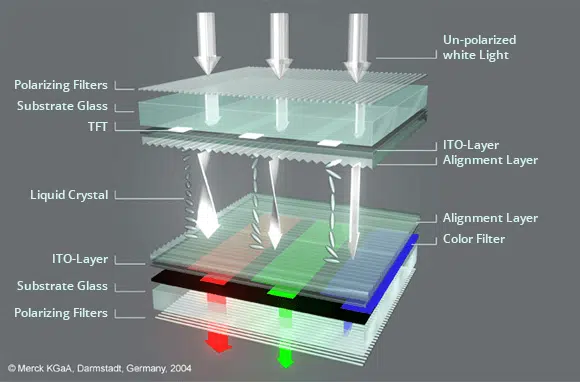Capacitive touch screen
Projective capacitive touch screens contain X and Y electrodes with insulating layers between them. Transparent electrodes are usually made in a diamond pattern with an ITO and a metal bridge.
The human body conducts electricity because it contains water. Projective capacitance technology uses the electrical conductivity of the human body. When a bare finger touches a sensor with an X and Y electrode pattern, capacitive coupling occurs between the human finger and the electrode, which changes the electrostatic capacity between the X and Y electrodes. The touch screen controller detects the change and position of the electrostatic field.
Resistive touch screen
Resistive touch screens are made of a glass substrate as the bottom layer and a thin film substrate (usually transparent polycarbonate or PET) as the top layer, each coated with a transparent conductive layer (ITO: indium tin oxide), separated by spacing points to form a small gap. The two conductive layers (ITO) of the material face each other. When the user touches parts of the screen with a finger or stylus, thin layers of conductive ITO touch. It changes the drag. The RTP controller detects the change and calculates the touch position. Contact points are detected by changes in voltage.

| Resistive Touch Screen | Capacitive Touch Screen | |
| Manufacturing Process | Simple | More complicated |
| Cost | Lower | Higher: Depending on size, number of touches |
| Touch Screen Control Type | Requires pressure on the touchscreen. | Can sense proximity of finger. |
| Power Consumption | Lower | Higher |
| touch with thick gloves | Always good | more expensive, need special touch controller |
| Touch Points | Single Touch Only | Single, two, gesture or Multi-Touch |
| Touch Sensitivity | Low | High (Adjustable) |
| Touch Resolution | High | Relatively low |
| Touch Material | Any type | Fingers. Can be designed to use other materials like glove, stylus, pencil etc. |
| False Touch Rejection | False touches can result when two fingers touch the screen at same time. | Good Performance |
| Immunity to EMI | Good | Need to special design for EMI |
| Image Clarity | Less transparent and smoky looking | Very high transparent especially with optical bonding and surface treatment |
| Sliders or Rotary Knobs | Possible, but not easy to use | Very good |
| Cover Glass | None | Flexible with different shapes, colors, holes etc. |
| Overlay | Can be done | No |
| Curve Surface | Difficult | Available |
| Size | Small to medium | Small to very big size |
| Immunity to Objects/Contaminants on Screen | Good | Need to special design to avoid false touch |
| Resistant to Chemical Cleaners | No | Good |
| Durability | Good | Excellent |
| Impact Ball Drop Test | Surface film protected | Need special design for smash |
| Scratch Resistance | As high as 3H | As high as 9H |
| UV Degradation Protection | Less protection |
Capacitive touch screen
Projective capacitive touch screens contain X and Y electrodes with insulating layers between them. Transparent electrodes are usually made in a diamond pattern with an ITO and a metal bridge.
The human body conducts electricity because it contains water. Projective capacitance technology uses the electrical conductivity of the human body. When a bare finger touches a sensor with an X and Y electrode pattern, capacitive coupling occurs between the human finger and the electrode, which changes the electrostatic capacity between the X and Y electrodes. The touch screen controller detects the change and position of the electrostatic field.
Resistive touch screen
Resistive touch screens are made of a glass substrate as the bottom layer and a thin film substrate (usually transparent polycarbonate or PET) as the top layer, each coated with a transparent conductive layer (ITO: indium tin oxide), separated by spacing points to form a small gap. The two conductive layers (ITO) of the material face each other. When the user touches parts of the screen with a finger or stylus, thin layers of conductive ITO touch. It changes the drag. The RTP controller detects the change and calculates the touch position. Contact points are detected by changes in voltage.